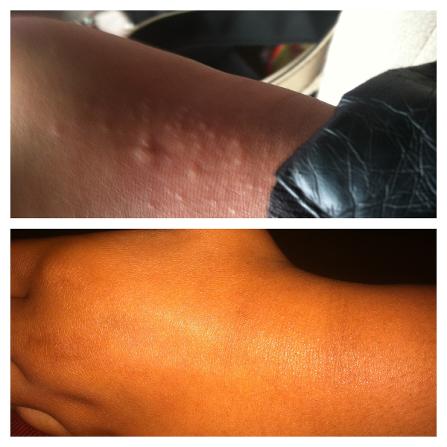
Our Cleansing Methods:
We use Black soap, Oatmeal bar or Botanical bars daily.
These bars may help
calm inflamed skin.

Bathing:
The best way we have found to cleanse irritated skin is to soak in the bath
Using black soap/Oatmeal bar
and Botanical oil
Pat dry,
then moisturize with Shea Butter.

Moisturizing:
Massage a generous amount of Naturalz Whipped Shea Butter into skin gently.

For outbreaks that are severe or stay wet,
We use aloe inner gel from leaf
to calm and dry area. After the area is dry, we soothe, moisturize area with Naturalz Botanical salve or eczema friendly body butters.
You have to find out which products & routine work best for your skin. We are just guides to show you what processes have worked for us and many other clients through the years of service to our community.
External Skincare is only the first step. For long term avoidance of irritations, consumption patterns must be considered.
1. Identifying Irritant:
What have you eaten?
Many people with eczema have an "allergy" to one of these foods
1 Dairy based Milk
2 Eggs
3 Fish (e.g., bass, flounder, cod)
4 Crustacean shellfish (e.g., crab, lobster, shrimp)
5 Tree nuts (e.g., almonds, walnuts, pecans)
6 Peanuts
7 Wheat
8 Soybeans, legumes
Additives/preservatives
An elimination diet can identify which allergens are causing sensitivity reactions.
A majority of your immune system is centralized in your gut.
It is called your gut microbiome.
You have to keep a healthy balance a of good and bad bacterias to control eczema symptoms.
Keeping a clean diet free from animal based products, refined grains/sugars, and processed/fast foods may help regulate your gut microbiome, thus providing clearer skin results.
Eating foods with prebiotics like
onions, apples, green leafy vegetable.
And probiotics like cinnamon, ginseng, and licorice
will help regulate the ratio of beneficial bacterias.
What is a prebiotic?
Dietary fiber that feeds friendly bacteria in your gut.
What is a probiotics?
Good live bacteria that feeds on non beneficial bacteria overgrowth.
2. What have you put on your skin?
Using the most natural, simple ingredients is the best way to continuously control outbreaks externally.
If you can't pronounce it or recognize its origin,
more than likely it will not be a good choice for your skin. We have found that products free of sulfates, parabens, fragrance, and harsh detergents work best for our skin.
Drink lots of natural spring water to hydrate the body and skin.
Incorporate more fresh fruits and vegetables into your consumption patterns for the best results.

If you have sensitive skin you should avoid these ingredients.
DEA (diethanolamine), TEA (triethanolamine) & MEA (Monoethanolamine)
These chemicals are used in personal care products to adjust the PH of the formulation they can cause allergic reactions, eye irritation, and toxicity when used over long periods of time.
Diazolidinyl Urea- also known as mammal urine! This ingredient can cause dermatitis, and itching/burning of the mucous membranes.
Anionic Surfactants – are used in about 90% of foaming personal care products. They are also used in car washes,garage floor cleaners, and as engine degreasers.
Some common anionic surfactants include: Sodium Lauryl Sulfate(SLS), Sodium Laureth Sulfate (SLES), Ammonium Lauryl Sulfate (ALS), Avoid all of these ingredients if they are on the label! Most commercial Beauty Bars contain these harsh ingredients.
Mineral Oil: Also called liquid paraffinum, mineral oil is a byproduct of petroleum that coats the skin like plastic.
It disrupts the skin's natural ability to purge itself of toxins, slows down cell function and can cause premature aging.
Baby oil, vaseline is 100% mineral oil.
Propylene/Butylene Glycol: This chemical compound is considered so toxic by the EPA that it mandates that its workers wear protective equipment when handling it.
It is a petroleum product that penetrates the skin easily and can cause brain, liver, and kidney malfunctions. (This ingredient is often found in stick deodorants where it can cause acute and chronic health hazards.)
The statements on this site have not been evaluated by the Food and Drug Administration. I am not a medical professional. The information provided is for educational and informational purposes only and solely as a self-help tool for your own use. Products found within are not intended to diagnose, treat, cure or prevent any diseases.




